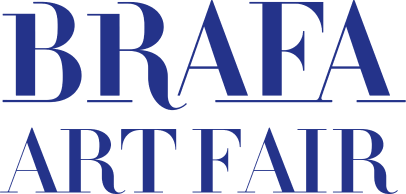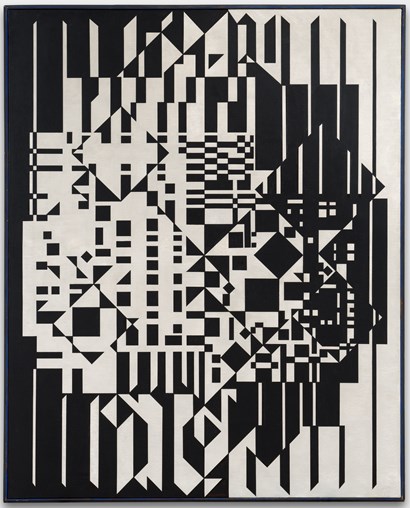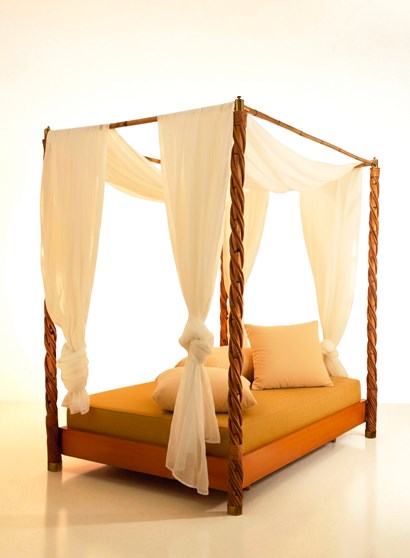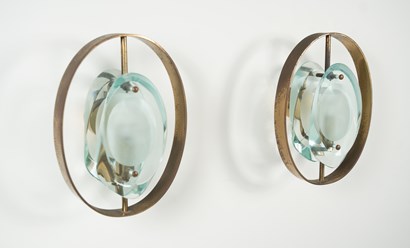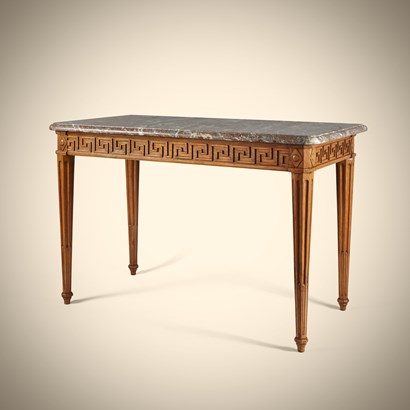This section will be available this Autumn.

Galerie BG Arts
Georges Clairin (Paris 1843-1919 Clohars-Carnoët) Portrait of Suzanne Lalique Oil on canvas 140 x 80 cm Signed 'Á Suzanne Lalique son ami G. Clairin' Provenance: property of Suzanne Lalique-Haviland; private collection, France Literature: Maritch-Haviland, N. de Léobardy, C., Lalique-Haviland-Burty Family Portraits, Limoges, 2009, p. 29, ill. in a group photograph, taken at Cours-la-Reine in Paris, showing Suzanne Lalique wearing this same dress for a costume ball to mark her birthday in about 1913 Georges Clairin is best remembered as an orientialist and portrait artist. He was a close friend and advisor to René Lalique. They regularly had dinner together and shared an interest in oriental objects, as well as travelling together to Venice. Clairin belonged to the bohemian world and painted Sarah Bernhardt, the celebrated actress of the day, in her different roles on numerous occasions. He also introduced her to Lalique, and she became one of Lalique’s most significant patrons for whom he designed jewellery. For both men, women were a constant theme of their work. As a family friend it is not surprising that Clairin should have painted Suzanne, René Lalique’s daughter, in costume for her birthday ball in 1913.

Franck Anelli Fine Art
claude corneille de lyon
Claude Corneille de Lyon (The Netherlands, The Hague 1500-1575 Lyon, France) Portrait of a wealthy merchant wearing a fur-lined coat and gold chain, circa 1560 Oil on panel 15 x 18 cm Certificate from Dr. Alexandra Zvereva This painting will be included in the supplement to the artist's forthcoming Catalogue Raisonné This unpublished small portrait fits naturally into the later works of one of the most illustrious portraitists of the French Renaissance. Referred to in contemporary documents by the name of his hometown, La Haye, he later became known simply as 'Corneille' until André Félibien, who believed him to be from the banks of the Rhône, added the name 'Lyon' in the index of his Entretiens. Born and trained in the Netherlands, probably in Flanders, the artist settled in Lyon as early as 1533. There, he succeeded Jean Perréal, the portraitist of Charles VIII and Louis XII, renowned for his intimate portraits with coloured backgrounds. By the mid-1530s, Corneille had gained such fame that he found himself painting the courtiers accompanying the king to Lyon, as well as the Sons and Daughters of France. However, unlike Perréal, his career was not that of a royal artist following the court. He never left Lyon, and his titles of "painter to the Dauphin" and later "painter and ordinary valet to the king" were purely honorary, primarily granting him the privileges of royal officers. The prominent citizens of Lyon, wealthy French and foreign merchants, high-ranking royal officers, well-to-do bourgeois, and magistrates made up the bulk of his clientele. Corneille created small-scale portraits for them, painted in just a few sitting sessions directly onto panels. Intended for family and close associates, these works had no official circulation and existed in only one unique copy, unlike portraits of the nobility, of which Corneille often made replicas that were widely circulated. The subject of this portrait is not a nobleman, despite his evident wealth. His attire is simple, a dark brown-black without any ornamentation, slashing, or jewels. The white ruff of his shirt is not starched. His high cap, fashionable in the 1550s-1560s, lacks a plume, a privilege reserved for the nobility, as it was associated with the feathers adorning knights' helmets. However, the man does possess a certain fortune, as evidenced by his fur-lined cloak of marten with wide lapels and a large gold chain with three rows of links, favoured by the Flemish. The medallion on the chain is cropped by the frame. This is almost certainly a prosperous merchant, eager to demonstrate his success and preserve the memory of his features for his family. The absence of any inscription on the reverse, giving the name of the subject, makes identification impossible, since no replica or engraving exists. Despite previous restorations, particularly to the face and background, the distinctive characteristics of Corneille’s art are clearly visible here, such as the rough sketching of the ear, the sloping shoulders that make the head appear slightly disproportionate to the torso, the treatment of the hair with individual strands, the brilliant irises crossed by an oblique ray of light, and the broader brushstrokes in the clothing.
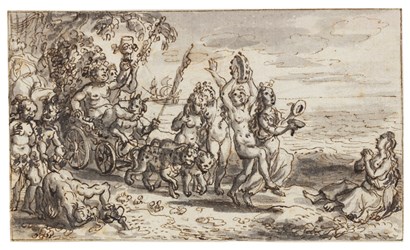
Galerie Lowet de Wotrenge
david vinckboons (mechelen 1576 - 1629 amsterdam)
David Vinckboons (Mechelen 1576-1629 Amsterdam) The Triumph of Bacchus Pen and brown ink and grey wash over black chalk, within brown ink framing lines on laid paper 68 x 114 mm Provenance: Dr. Einar Perman (1893-1976), Stockholm; by descent to the previous owners; sale, New York, Sotheby's, 31 January 2024, lot 104 Literature: Laren, Singer Museum, Oude Tekeningen uit de Nederlanden. Verzameling Prof. E. Perman, Stockholm, 1962, cat. n° 121 (as Adriaen van de Venne)
_ChristoandJeanne-Claude_T638932180913780762.jpg?width=410&height=2000&qlt=90&scale=both&mode=max&format=jpeg)
Edouard Simoens Gallery
christo and jeanne-claude
Christo (Bulgaria 1935-2020 New York) and Jeanne-Claude (Casablanca 1935-2009 New York) The Pont Neuf Wrapped (Project for Paris), 1985 Pencil, charcoal, pastel, wax crayon, and technical data 144 x 165 cm (overall) Provenance: Wolfgang Volz collection; private collection Literature: Christo and Jeanne-Claude: Water Projects, Silvana 2016, p. 167

Stéphane Renard Fine Art
rosalba carriera
Rosalba Carriera (Venice, 1673-1757) Portrait of Joseph Smith and Catherine Tofts as Thalia Tempera on ivory 8.79 x 11 cm This miniature has been the subject of a detailed study by Mrs. Bożena Anna Kowalczyk. In addition, the attribution of this miniature to Rosalba Carriera has been confirmed by Bernardina Sani, based upon digital photos.
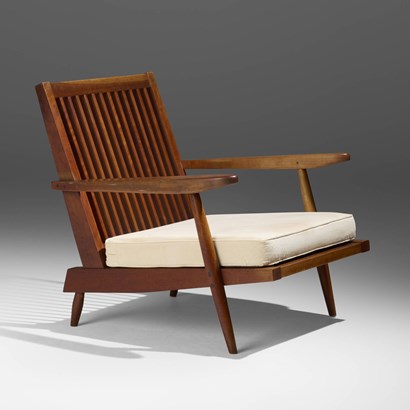
Laurent Schaubroeck
George Nakashima (USA, Washington 1905-1990 Pennsylvenia) Cushion chair with arms, 1960s Black American cherry, upholstery 77.5 x 74.3 x 86.4 cm Produced by George Nakashima Studio Includes a digital copy of the order card Provenance: Craighead family Produced by the Nakashima Studio in the 1960s, this lounge chair exemplifies George Nakashima’s refined craftsmanship and harmony between form and material. Its spindled back recalls Windsor traditions, while the tapered legs and clean geometry express his modern sensibility. Upholstered in white linen, the chair combines warmth and elegance, standing as a rare and timeless piece from one of the most influential American designers of the 20th century.

Galerie AB - Agnès Aittouarès
pablo picasso
Pablo Picasso (Malaga 1881-1973 Mougins) Two characters, séduction, 1953 Produced in Cannes on 16 December 1953 Ink on paper 20.9 x 26.4 cm Signed upper left and dated upper right Provenance: Scheffel Gallery, Bad Homburg, Germany; private collection, acquired from the Scheffel Gallery in 1989; private collection; private collection, Paris Literature: Christian Zervos, Pablo Picasso. Œuvres de 1953 à 1955, vol. 16, Paris, 1965, n° 57, p. 20; Dore Ashton, Picasso on Art: A Selection of Views, New York, 1972, p. 125

Samuel Vanhoegaerden Gallery
Bram Bogart (Delft 1921-2012 Sint Truiden) Hooigang, September 1964 Mixed media on canvas, mounted on wooden panel 106 x 124 cm Signed, dated and titled on reverse Provenance: D & R Hughes, London, 1989; private collection, Belgium Literature: Bram Bogart, The early years, 1951-1965, D & R Hughes, 1989, ill. n° 49
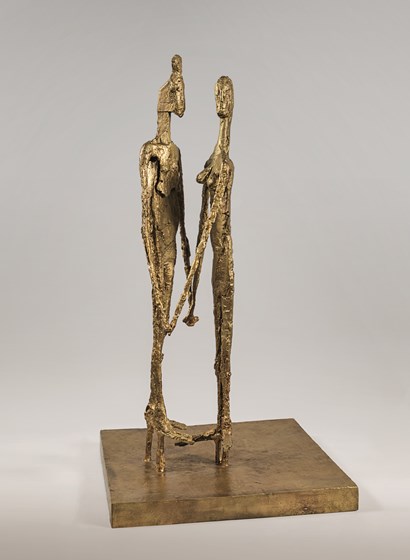
Galerie de la Béraudière
germaine richier
Germaine Richier (France, 1902-1959) Le Couple, 1956 Natural bronze Fonderie Susse, Paris Lost wax cast (except for the base and arms, sand casted) H 139 x W 74.5 x D 74.5 cm Signed and numbered on the terrasse: G. Richier, 3/6 Edition 3/6 out of 11 (1/6 - 6/6 + HC1-HC2-HC3 + EA + 0/6) Posthumous cast: 1963 Provenance: Galerie Creuzevault, Paris; private collection, France; Galerie Cazeau-Béraudière, Paris; private collection, France; private collection, Belgium Literature: Jean-Louis Prat et Françoise Guiter, Germaine Richier, Rétrospective, Saint-Paul-de-Vence, Fondation Maeght, 1996, p. 172, ill. (another cast); Maîtres des XIXe et XXe siècles, Galerie H. Odermatt-Ph. Cazeau, Paris, 1989, repr. n° 46; Eddie Wolfram et William Packer, London, art and artist, Londres, juillet 1973, n° 8, pp. 46-49; Germaine Richier, Galerie Creuzevault, Paris, 1966 Exhibitions: 2022, Brussels, Galerie de la Béraudière, Germaine Richier et la couleur (this cast); 1996, Saint-Paul-de-Vence, Fondation Maeght, Germaine Richier, Rétrospective (another cast); 1957, Paris, Musée d'Art Moderne de la Ville de Paris, XIIIe Salon de Mai, n° 27, ill. (another cast); 1956, Paris, Musée National d'Art Moderne, Germaine Richier, n° 13, referred as 'Figures' (another cast); Jean Cassou, Richier, Editions du Temps, Paris, 1961; René de Solier, Germaine Richier, in Les Cahiers d'art, Paris, juin 1953, n° 28, pp. 123-129 With Le Couple, Germaine Richier reached a point of fulfilment in her exploration of the human figure and its metamorphoses. The two figures, united by a skilful interplay of triangles and balances, seem caught in a silent movement where tension becomes harmony. The rigour of the construction is combined with an organic, almost primitive energy that animates the bronze with a vibrant presence. Le Couple embodies this rare alliance between construction and emotion, where the bronze material seems to be animated by a vital breath.

Vagabond Antiques
Pair of carved Heraldic stone lions Central European, Hapsburg Territories, late 17th century Carved limestone H 90 x W 57 x D 77 cm A striking pair of limestone lions, carved in full relief and designed as true opposites. Each is seated upright, with bared teeth, strong haunches and tightly curled manes. Both wear a crown and hold an oval cartouche carved in bold relief with an interlaced monogram. They were made to flank the formal entrance of a major estate. The form and detailing are typical of high-status Baroque culture in Central Europe and the crown design is especially telling. Each features a repeating pattern of fleur-de-lis and crosses, closely following the design of imperial crowns used in Habsburg heraldry - particularly in the realms of Austria and Bohemia. A crucial distinction is the placement of such a crown directly on the animal - not merely above the cipher - which indicates an emblem of royal standing. Comparable examples can be seen on the monumental lions at Prince Eugene of Savoy's Upper Belvedere Palace in Vienna and others across Bavaria and Austria, where lions were used as heraldic supporters for noble or imperial arms. The monograms are hard to decipher but are almost certainly ciphers for the original owners or patrons. They likely stood at the gates of a major estate or seat of power under Habsburg rule or allegiance, marking out territories and status.
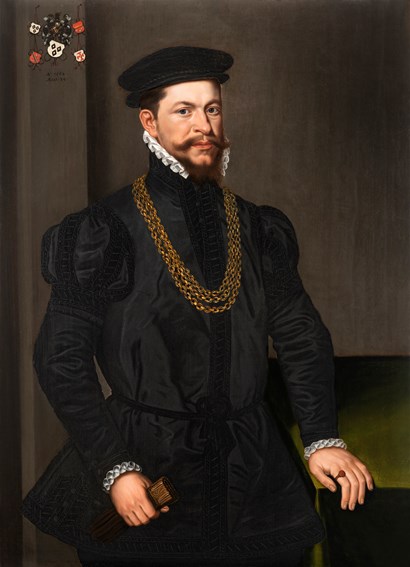
Galerie Lowet de Wotrenge
frans pourbus the elder (bruges 1545/46 - 1581 antwerp)
Frans Pourbus the Elder (Bruges 1545-1581 Antwerp) Portrait of Peeter van Panhuys, alderman and treasurer of Antwerp, 1562 Oil on oak panel 105 x 75 cm Dated upper left 'A°. 1562' and inscribed below the date ‘Aetat: 34’ Provenance: private collection, Belgium Literature: R. Willmott, Antwerp and the Golden Age: Culture, Conflict and Commerce, Unicorn, 2025 (ill.) In an era when wealth and power increasingly resided not in hereditary titles but in commerce and banking, Frans I Pourbus captured the self-assured gaze of the new elite. This striking portrait depicts Peeter van Panhuys - merchant, banker's agent, and future treasurer of Antwerp - at a pivotal moment in his rise through one of Europe's most dynamic commercial centers. The work's contemporary resonance is unmistakable. Van Panhuys embodies the entrepreneurial spirit that still defines global finance, yet his story also reflects our modern anxieties: barely two decades after this portrait was painted, religious conflict forced him to flee Antwerp as a refugee, abandoning everything he had built. His biography encapsulates the precariousness of prosperity in times of social upheaval - a theme that speaks powerfully to today's world of political instability and forced migration. Pourbus renders his subject with remarkable psychological acuity. The prominent gold chain and exquisitely detailed black doublet announce van Panhuys' status, while the crisp white ruff - painted with virtuosic precision - frames a face of penetrating intelligence. In his left hand, he holds a pair of gloves, a refined accessory that signals his gentlemanly aspirations and membership in Antwerp's sophisticated mercantile elite. Recently rediscovered from a Belgian private collection, the sitter's identity is confirmed through his appearance in Maerten de Vos's monumental family portrait at the Mauritshuis, where van Panhuys stands among the interconnected dynasties that dominated Antwerp's Golden Age. This painting invites us to reconsider the origins of our modern world - built not by kings and generals, but by ambitious merchants whose portraits demanded the same dignity once reserved for nobility.
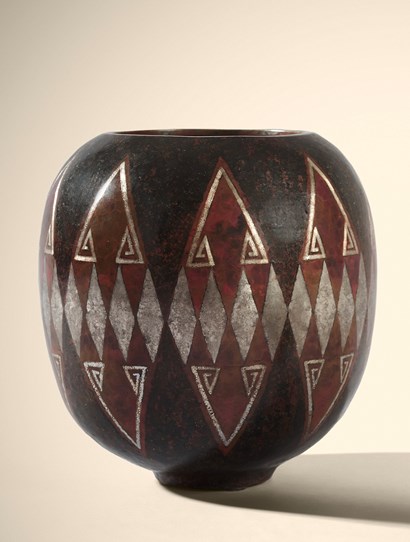
Galerie Mathivet
claudius linossier
Claudius Linossier (Lyon, 1893-1953) Vase, circa 1930 Copper dinanderie on a fire-patinated ground with red tones in the central section and black shading at the top and bottom, decorated with an inlaid silver frieze and silver triangles H 18 cm - ∅ 18 cm Signed 'Linossier'
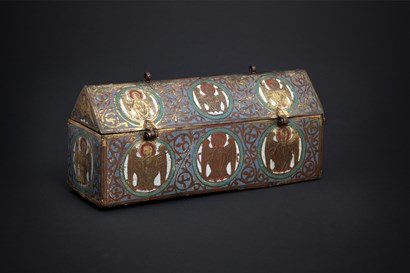
Art et Patrimoine - Laurence Lenne
Reliquary 'in the form of a sarcophagus with a hinged roof' Limoges, mid-13th century Gilt copper plates, champlevé enamels H 11.8 x W 27.5 x D 9.5 cm Literature: Inventaire général des monuments et des richesses artistiques de la France. Emaux limousins du Moyen Age. Correze/Creuse/Haute-Vienne, under the direction of Paul-Édouard Robinne, Éditions de l’Inventaire, Images du Patrimoine, 1995; Emaux de Limoges XIIè-XIXè siècle, under the direction of Jacques Toussaint, Museum of Ancient Arts of Namur, 1996; Valérie & Thomas Becket, De l'influence des princes Plantagenêt dans l'Oeuvre de Limoges, Municipal Museum of the Bishop’s Palace-Museum of Enamel, Limoges, 1999 A reliquary, without a wooden core, taking the shape of a sarcophagus with a hinged roof. It is made of gilt copper plates and decorated with champlevé enamels depicting sixteen half-length angels emerging from clouds against a white enamel background. The decoration consists of two superimposed registers of three engraved gilt angels set within round medallions. The medallions stand out against a blue enamel ground adorned with gilded Gothic foliage and interlace patterns. This reliquary belongs to a series of standardised reliquaries known from the Limousin region, all dating from the 13th century. Its dimensions make it one of the largest examples of this 'sarcophagus with movable roof' type. It is closely related to the exceptional large reliquary of Saint-Yrieix-la-Perche, classified as part of the Treasure of the French Historic Monuments.

Virginie Devillez Fine Art
pierre-louis flouquet
Pierre-Louis Flouquet (Paris 1900-1967 Brussels) Féminités, circa 1923-1925 Oil on canvas 125 x 87 cm Signed lower right 'flouquet' Provenance: Galerie Patrick Derom, Brussels; private collection, Brussels; private collection, Brussels (by descent to the present owner) Literature: Serge Goyens de Heusch, Pierre-Louis Flouquet. 1900-1967, Brussels, Fondation pour l’Art belge, 1993, (ill. p. 56) Exhibitions: Brussels, Galerie Patrick Derom, The Avant-garde of the 1920s in Belgium, 1992, cat. n° 12 (ill.); Drogenbos, FeliXart Museum, L’Équerre / 7 Arts 1923, scenographic reconstruction of the fair stand of the publishing house L’Équerre, 2008-2011, no catalogue published Born in Paris, Pierre-Louis Flouquet was nine years old when his family moved to Brussels. Mainly self-taught, he received a brief artistic education at the Académie des Beaux-Arts in Brussels, where he met, among others, Victor Servranckx and René Magritte. The latter soon shared a studio with Flouquet, who began producing geometric works that represented a true synthesis of Cubism and Futurism. Throughout the 1920s, Flouquet exhibited frequently on the international stage - in Paris, Madrid, New York, Chicago, Buenos Aires, and Berlin, at the Galerie Der Sturm. For the gallery’s eponymous magazine, Flouquet even designed a large number of covers. During this period, he developed an art that evolved primarily through distinct series: Paysage plastique, Féminités, Composition, Formes, and Construction. The large-scale painting Féminités belongs to the series of the same name, begun in 1922, which explores geometric variations on the morphology of the female body. The rigor and purity that Flouquet infused into these anthropomorphic stylizations - further emphasized by his distinctive sense of composition - reveal his fascination with the formal perfection of the new technological creations of the modern age. Yet, in Flouquet’s work, as in that of Fernand Léger, such faith in mechanical forms does not lead to a total rejection of figuration, but rather to a search for plastic correspondences between the human and the machine. The composition Féminités is particularly harmonious, achieving a balance between line and color, enhanced by a marble-like background that lends warmth to the work.

Kunsthaus Kende
Satoshi Hara (Japan, Yokohama, 1962) Flower vase with inlaid Chrysanthemum design (mujinagiku) Ishikawa, 2018 Gold, silver and iron H 18 cm - Ø 20 cm Provenance: artist’s estate Satoshi Hara, who was born in Yokohama, Kanagawa Prefecture in 1962, specialises in creating hammered metalworks embellished with intricate and labour-intensive decorations in gold and silver. This highly developed inlay technique makes the decorations appear as if they were drawn with a thin pen. The artist has created his own technique, which he calls ‘Nanako Zogan.’ With this technique, he is able to inlay patterns into the vessels using 0.3 mm-thick silver wires. Each individual line is created in five different steps. One piece of work contains an average of 50 metres of silver wire, meaning that the artist has to work with approximately 200 metres of silver wire throughout the various stages. There is no room for error in this highly complex and time-consuming process, since it is impossible to rectify any mistakes. The artist has been teaching metalworking at Kanazawa College of Art, Department of Craft, since 2003. His work can be found in numerous museums in Japan and abroad.
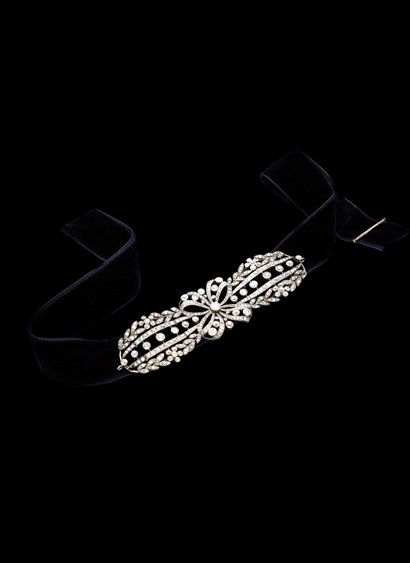
Pauline's Jewellery Box
Belle Epoque diamond tiara necklace, circa 1905 Platinum and diamonds Provenance: private collection, London An important Belle Epoque diamond tiara necklace, set with old European & rose cut diamonds. The estimated total diamond weight is approximately 12.00 carats. Estimated colour H-I on average. Estimated clarity VS-SI on average. The diamonds are bright & lively, mounted in platinum.

